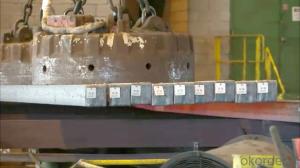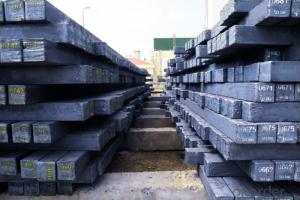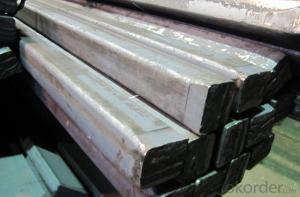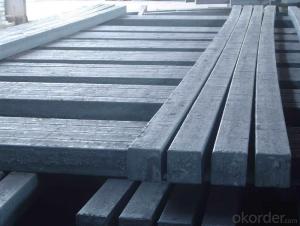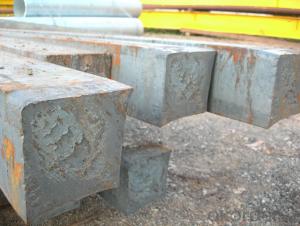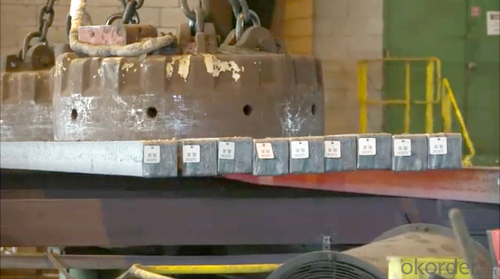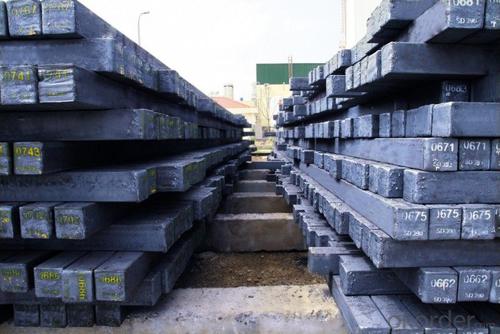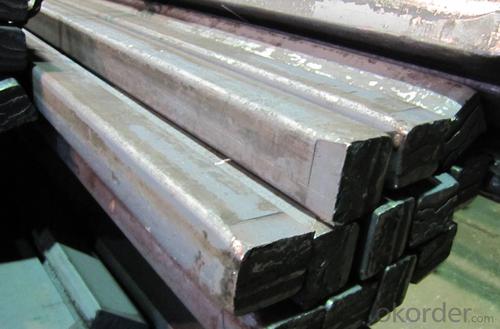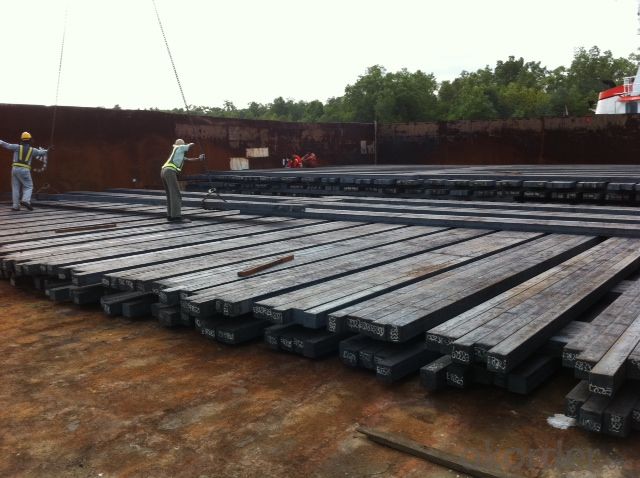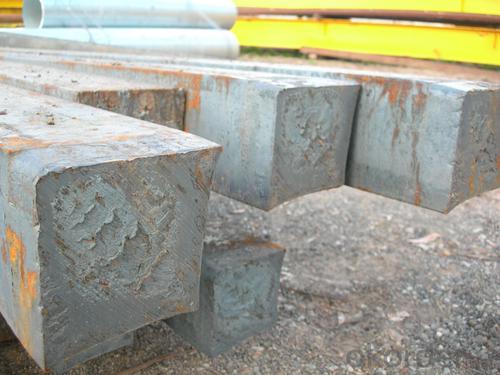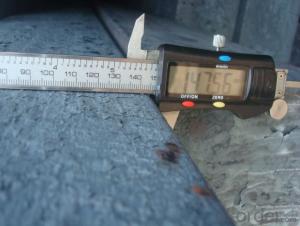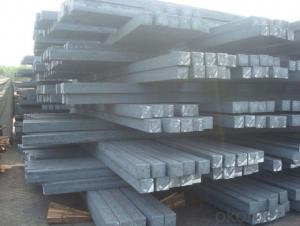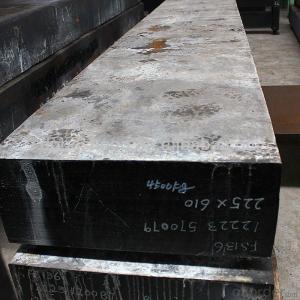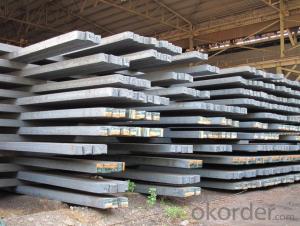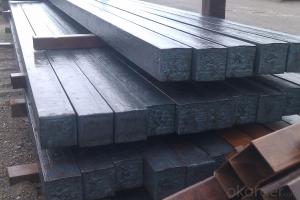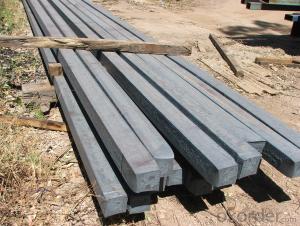Prime Q275 145mm Square Alloy Steel Billet
- Loading Port:
- Shanghai
- Payment Terms:
- TT OR LC
- Min Order Qty:
- 100 m.t.
- Supply Capability:
- 10000 m.t./month
OKorder Service Pledge
OKorder Financial Service
You Might Also Like
Structure of Prime Q275 145mm Square Alloy Steel Billet
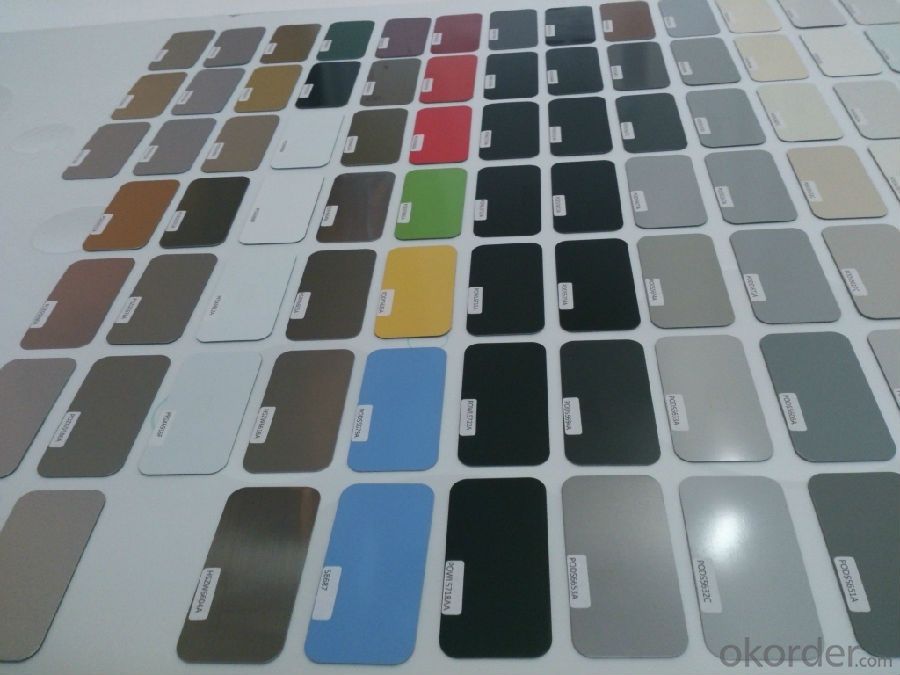
Description of Prime Q275 145mm Square Alloy Steel Billet
1. Prepainted steel coil is coated with organic layer, which provides higher anti-corrosion property and a longer lifespan than that of galvanized or galvalume steel sheets.
2. The base metals for prepainted steel coil consist of cold rolled, HDGI Steel, electro-galvanized and hot-dip alu-zinc coated steel. The finish coats of prepainted steel coil can be classified into groups as follows: polyester, silicon modified polyesters, polyvinylidene fluoride, high-durability polyester, etc.
3. The production process has evolved from one-coating-and-one-baking to double-coating-and-double-baking, and even three-coating-and-three-baking.
4. The color of the prepainted steel coil has a very wide selection, like orange, cream-colored, dark sky blue, sea blue, bright red, brick red, ivory white, porcelain blue, etc.
5. The prepainted steel coils can also be classified into groups by their surface textures, namely regular prepainted sheets, embossed sheets and printed sheets.

Main Feature of Prime Q275 145mm Square Alloy Steel Billet
They were one of several reasons for the wind to be taken out of the sails of the recent oil price momentum. Kuwait’s oil minister said that his country would only commit to a production freeze if all major producers are involved, including Iran. We also had Goldman telling us that oil markets will not rebalance at $40/bbl as it throws a lifeline to cash-strapped US producers.
If it is talk of a production freeze that is behind the rally it shows how low expectations have fallen. It is in the nature of oil people to talk the market up. Any bullish crumb is given exaggerated significance and any port in a storm will do. It is all but fact that the oil market will be tighter in the second half of this year when seasonal demand shoots up and US production continues to decline. It was the same picture last year. If OPEC and key non-OPEC production is frozen that will ensure the daily surplus will fall, but in all likelihood there will still be a surplus and there is an enormous global stockbuild to burn off.
Applications of Prime Q275 145mm Square Alloy Steel Billet
A. Corrugated design makes it excellent waterproof performance
B. Materials as prepainted steel sheets, galvanized steel sheets, galvalume (Al-Zn coated sheets) are available to make corrugated sheet.
C.Those material are durable, anti-corrosion in bad weather for 20-30 years based on it's Zinc(Galvanized) coating or AZ (Galvalume) coating.
D. Different shape of the sheet make it suitable for any style of buildings.
E.Easy to install, no need special tools to fix the sheet.
F.Light weight due to high strength to weight ratio of steel. Light weight means easier handling lower shipping costs, easier installation
G. Different color is availbe base on the RAL Standard make your building more beautiful.
H. We will provide the best solutions if you don't have a exact idea of the specification you want for the steel sheet based on your weather conditions, engineering structure, construction budget and so on.
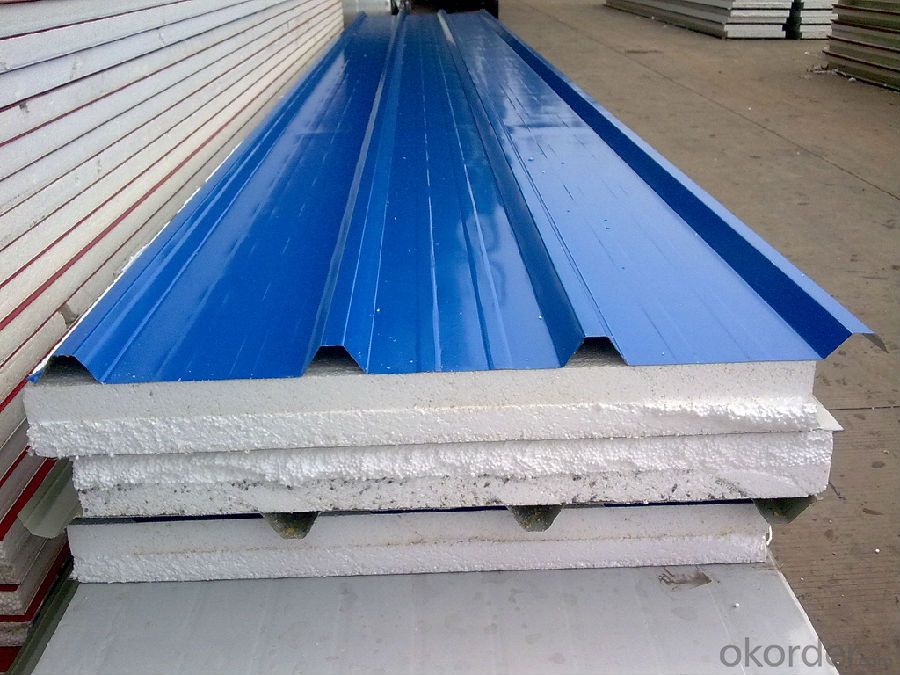
Specifications of Prime Q275 145mm Square Alloy Steel Billet
Product | Billet |
Material Grade | SGCC / SGCH / DX51D+AZ, etc |
Thickness | 0.6-3.0mm |
Width | 500-1500mm |
Tolerance | Thickness: +/-0.02mm , Width:+/-2mm |
Zinc-coating | Z30-150g/m2 |
Technique | Raw material: Hot rolled steel coil --> Cold rolled_>hot dipped galvalume |
Surface | Dried, Chromated, Unoiled |
Spangle | Regular spangle , small spangle, zero spangle |
ID | 508MM 610MM |
Coil weight | 1-25MT |
Export package | Cardboard inner sleeves, Waterproof paper, galvanized steel covered and steel strip packed |
FAQ of Prime Q275 145mm Square Alloy Steel Billet
We have organized several common questions for our clients,may help you sincerely:
1. How Can I Visit There?
Our company is located in Tianjin City, China, near Beijing. You can fly to Tianjin Airport Directly. All our clients, from home or aboard, are warmly welcome to visit us!
2. How Can I Get Some Sample?
We are honored to offer you sample.
- Q: What are the main factors that affect the competitiveness of steel billets manufacturers?
- The main factors that affect the competitiveness of steel billet manufacturers include cost of production, quality of products, technological advancements, availability of raw materials, economies of scale, market demand, pricing strategies, and competitiveness of rival manufacturers.
- Q: What are the common applications of steel billets?
- Steel billets are commonly used as raw material for the production of various steel products, such as bars, rods, wire, pipes, and tubes. They are also utilized in the automotive industry for manufacturing parts like crankshafts, camshafts, and gears. Additionally, steel billets find applications in construction for producing structural elements like beams, columns, and girders.
- Q: How are steel billets used in the production of marine parts?
- Steel billets are an integral component in the production of marine parts. These billets, which are essentially semi-finished steel products, are used as the raw material for shaping and forming various marine components. To begin with, steel billets undergo a process called hot rolling, where they are heated to high temperatures and passed through rolling mills to produce different shapes and sizes. This hot rolling process helps in refining the steel's grain structure, enhancing its mechanical properties and making it suitable for marine applications. Once the desired shape and size are achieved, these billets are further processed through various techniques such as forging, machining, and welding to create specific marine parts. For instance, steel billets are used to manufacture propeller shafts, rudder stocks, and various structural components like hull frames and bulkheads. The high strength and durability of steel make it an excellent choice for marine parts, as it can withstand the harsh conditions of saltwater, extreme temperatures, and heavy loads. Additionally, steel billets can be easily customized to meet specific design requirements, ensuring the production of precise and reliable marine parts. Furthermore, steel billets also play a crucial role in the repair and maintenance of marine vessels. In cases where existing components need to be replaced, steel billets can be shaped and machined to match the exact specifications of the original parts. This ensures compatibility and seamless integration, allowing for efficient repairs and ensuring the continued operation of marine vessels. In conclusion, steel billets are essential in the production of marine parts as they provide the raw material necessary for shaping and forming various components. Their high strength, durability, and customization capabilities make steel billets an ideal choice for marine applications, ensuring the reliability and performance of marine vessels.
- Q: What is the role of steel billets in the manufacturing of structural steel bridges?
- Structural steel bridges heavily rely on steel billets, which are essential semi-finished products utilized as the raw material for manufacturing various steel products, including these bridges. The initial step involves heating the steel billets and passing them through a series of rolling mills to shape them accordingly. This rolling process ensures that the billets are converted into elongated, slender sections suitable for bridge construction. Once the steel billets have been rolled into the desired forms, they undergo further processing and fabrication to create the necessary components for structural steel bridges. These components encompass beams, columns, girders, and other vital elements that contribute to the bridge's strength, stability, and load-bearing capabilities. The utilization of steel billets in the production of structural steel bridges provides numerous advantages. Firstly, steel possesses an exceptional strength-to-weight ratio, rendering it an ideal material for constructing bridges capable of withstanding heavy loads while remaining relatively lightweight. Moreover, steel's versatility allows for the creation of intricate bridge designs that can accommodate diverse architectural and engineering requirements. Furthermore, steel billets exhibit high durability and resistance to environmental factors like corrosion, which is crucial for ensuring the long-term integrity and safety of the bridge structure. This durability ultimately contributes to the bridge's extended lifespan, leading to reduced maintenance and replacement costs over time. In conclusion, steel billets serve as the fundamental building blocks for the manufacturing of structural steel bridges. Through the rolling and fabrication processes, these billets are transformed into various components that collectively provide strength, stability, and durability to the bridge. The utilization of steel billets enables the construction of bridges capable of withstanding heavy loads, maintaining a lightweight nature, and enduring environmental factors, thereby ensuring the bridge's long-term integrity and safety.
- Q: What are the different types of steel billet rolling processes?
- In the manufacturing industry, various steel billet rolling processes are utilized. These include hot rolling, cold rolling, and warm rolling. The most commonly employed method for producing steel billets is hot rolling. In this procedure, the steel billet is heated to a high temperature and then passed through rolling mills to reduce its thickness and shape it as desired. The elevated temperature makes the steel more malleable, facilitating easy shaping and forming. On the other hand, cold rolling involves rolling the steel billet at room temperature or slightly below. This technique is typically employed to produce steel billets with greater precision and a smoother surface finish. Additionally, cold rolling enhances the mechanical properties of the steel, rendering it stronger and more durable. Warm rolling, as the name suggests, is a combination of hot rolling and cold rolling. In this approach, the steel billet is heated to a temperature lower than that used in hot rolling but higher than that used in cold rolling. The lower temperature preserves the mechanical properties of the steel while still allowing for shaping and forming. Each of these steel billet rolling processes possesses its own merits and demerits. Hot rolling is the most cost-effective and efficient method, although it may result in some surface defects. Cold rolling offers superior precision and surface finish, but it is more expensive and time-consuming. Warm rolling strikes a balance between the two, although it may not be suitable for all applications. Ultimately, the selection of the steel billet rolling process depends on various factors, including the desired shape and properties of the final product, production volume, and cost considerations.
- Q: What are the different surface treatments for improved weldability in steel billets?
- There are several surface treatments that can be employed to enhance the weldability of steel billets. These treatments are aimed at improving the cleanliness and quality of the surface, reducing impurities, and enhancing the overall performance of the weld. One common surface treatment method is mechanical cleaning. This process involves the removal of loose scale, rust, dirt, and other contaminants from the surface of the steel billets. Mechanical cleaning methods can include grinding, brushing, or shot blasting. By eliminating these impurities, the surface is prepared for better adhesion and fusion during the welding process. Another surface treatment option is chemical cleaning. This technique involves the use of various chemicals to remove oxides, oils, greases, and other organic or inorganic contaminants from the surface. Acid pickling is a commonly used chemical cleaning method, where the steel billets are immersed in an acid solution to dissolve and remove impurities. This process creates a clean and reactive surface that promotes better weldability. In addition to mechanical and chemical cleaning, surface coatings can also be applied to improve weldability. These coatings act as a barrier between the steel surface and the surrounding atmosphere, protecting it from oxidation and contamination during the welding process. Common coatings used for this purpose include zinc-based coatings, such as galvanizing or zinc-rich paints. These coatings not only protect the surface but also provide cathodic protection to prevent corrosion. Furthermore, some steel billets may undergo heat treatment processes to improve their weldability. Heat treatment involves subjecting the steel to controlled heating and cooling cycles to alter its microstructure and mechanical properties. Through heat treatment, the steel billets can be made more ductile, reducing the risk of cracking or failure during welding. Overall, the different surface treatments for improved weldability in steel billets include mechanical cleaning, chemical cleaning, surface coatings, and heat treatment. These treatments aim to remove impurities, increase cleanliness, and enhance the overall weldability of the steel, resulting in higher quality and more reliable welds.
- Q: How are steel billets used in the manufacturing of agricultural machinery parts?
- Steel billets are an important raw material in the manufacturing of agricultural machinery parts. These billets are essentially semi-finished steel products that are used as a starting point for various manufacturing processes. Firstly, steel billets are shaped into specific forms using various techniques such as casting, rolling, or extrusion. These processes help transform the solid billets into desired shapes, such as bars, rods, or sheets, which are then used as base materials for agricultural machinery parts. Once the billets are shaped, they are further worked upon through machining, cutting, and welding processes to create specific components for agricultural machinery. For example, billets can be machined into shafts, gears, or axles that are essential for the functioning of these machinery parts. Moreover, the strength and durability of steel billets make them suitable for applications in heavy machinery like tractors, combines, or harvesters. Agricultural machinery parts made from steel billets possess high tensile strength, resistance to wear and tear, and can withstand the demanding conditions encountered in the agricultural sector. In addition, steel billets can be heat-treated to enhance their mechanical properties, such as hardness or toughness, making them more robust and capable of withstanding heavy loads and extreme conditions. This makes them ideal for agricultural machinery parts that often face intense forces during operation. Furthermore, steel billets can be used in the manufacturing of precision components, such as bearings or bushings, which are crucial for smooth and efficient operation of agricultural machinery. The dimensional accuracy and consistency of steel billets ensure that these precision parts fit perfectly and function effectively. Overall, steel billets play a vital role in the manufacturing of agricultural machinery parts. Their versatility, strength, and ability to be shaped and processed make them an essential material in producing components that can withstand the demanding and challenging conditions of the agricultural industry.
- Q: How are steel billets inspected for chemical composition?
- Steel billets are typically inspected for chemical composition through a process called spectroscopy. In this method, a small sample is taken from the billet and analyzed using specialized instruments such as optical emission spectroscopy or X-ray fluorescence spectroscopy. These instruments measure the emission or absorption of specific wavelengths of light to determine the concentration of different elements present in the steel. This allows for accurate assessment of the chemical composition of the billet, ensuring it meets the required specifications.
- Q: What are the specifications for tool steel billets used in the manufacturing of cutting tools?
- The specifications for tool steel billets used in the manufacturing of cutting tools typically include factors such as high hardness, excellent wear resistance, good toughness, and high strength. Additionally, specific alloying elements and heat treatment processes are employed to enhance the performance and durability of the cutting tools.
- Q: How are steel billets cooled after the manufacturing process?
- Steel billets are typically cooled after the manufacturing process through a process known as water quenching. Water quenching involves rapidly cooling the steel billets by immersing them in a water bath or spraying a high-pressure water stream onto the billets. This rapid cooling process helps to control the microstructure of the steel, resulting in desirable properties such as increased strength and hardness. Water quenching is often preferred for steel billets because it allows for efficient and uniform cooling, ensuring consistent quality throughout the billets. Additionally, water quenching is a cost-effective method compared to other cooling methods. However, it is important to note that the cooling process may vary depending on the specific requirements of the steel being manufactured, and alternative cooling methods such as air cooling or oil quenching may also be utilized.
Send your message to us
Prime Q275 145mm Square Alloy Steel Billet
- Loading Port:
- Shanghai
- Payment Terms:
- TT OR LC
- Min Order Qty:
- 100 m.t.
- Supply Capability:
- 10000 m.t./month
OKorder Service Pledge
OKorder Financial Service
Similar products
Hot products
Hot Searches
Related keywords
